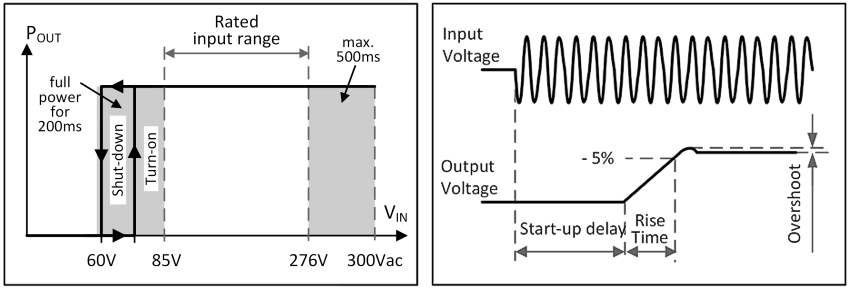AC input
AC input | |||
|---|---|---|---|
AC input | Nom. | AC 100 - 240 V | Suitable for TN, TT and IT networks |
AC input range | Min. | 85 - 276 Vac | Continuous operation |
Min. | 276 - 300 Vac | For up to 500 ms max. | |
Permissible voltage L or N to earth | Max. | 276 Vac | Continuous according to IEC 60664-1 |
Input frequency | Nom. | 50 - 60 Hz | ±6 % |
Turn-on voltage | Typ. | 81 Vac | Static, see Fig. Input voltage range; switch-on behavior definitions |
Shut-down voltage | Typ. | 63 Vac | Static, see Fig. Input voltage range; switch-on behavior definitions |
Typ. | 55 Vac | Dynamic value | |
AC input |
| AC 100 V | AC 120 V | AC 230 V |
|
|---|---|---|---|---|---|
Input current | Typ. | 2.65 A | 2.22 A | 1.22 A | At 24 V, 10 A, see Fig. Input current over output current; power factor over output current |
Power factor*) | Typ. | 0.99 | 0.98 | 0.92 | At 24 V, 10 A, see Fig. Input current over output current; power factor over output current |
Peak factor**) | Typ. | 1.65 | 1.67 | 1.85 | At 24 V, 10 A |
Start-up delay | Typ. | 800 ms | 650 ms | 340 ms | See Fig. Input voltage range; switch-on behavior definitions |
Rise time | Typ. | 8 ms | 8 ms | 8 ms | At 24 V, 10 A, continuous current, 0 mF load capacitance, see fig. Input voltage range; switch-on behavior - definitions |
Typ. | 15 ms | 15 ms | 15 ms | At 24 V, 10 A, continuous current, 10 mF load capacitance, see fig. Input voltage range; switch-on behavior - definitions | |
Turn-on overshoot | Max. | 100 mV | 100 mV | 100 mV | See Fig. Input voltage range; switch-on behavior definitions |
*) The power factor is the ratio of real (or active) power to apparent power in an AC circuit. **) The peak factor is the mathematical ratio of the peak value to the RMS value of the input current waveform. | |||||
 Fig.1: Input voltage range; switch-on behavior definitions
Fig.1: Input voltage range; switch-on behavior definitions Fig.2: Input current over output current; power factor over output current
Fig.2: Input current over output current; power factor over output current